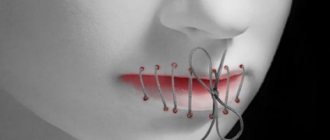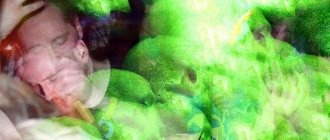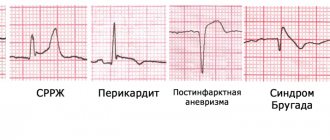Impaired consciousness is expressed in quantitative and qualitative changes.
Towards quantitative syndromes
disturbances (depression) of consciousness include: stupor, stupor, coma.
Towards qualitative syndromes
disturbances (stupidity) of consciousness include: delirious syndrome, oneiric state, amentia, twilight state of consciousness.
Quantitative disturbances of consciousness (depression of consciousness) develop due to morphological or pronounced metabolic changes in the brain, and are accompanied by a decrease in the level of wakefulness, motor activity, intellectual functions, up to complete depression and switching off of consciousness.
Stupefaction: degrees of depression of consciousness and symptoms
Traditionally, stunned consciousness is usually divided into separate categories depending on the degree of mental depression into disorders: moderate and severe.
Moderate stunned
The main manifestations of moderate severity of stunning syndrome are a noticeable slowdown in all thought processes, significant difficulty in using cognitive resources, and a significant impoverishment of mental potential . With this disorder, the patient experiences a decrease in the possibility of active attention: he is not capable of purposeful, voluntary and controlled concentration of thoughts, vision, hearing on any processes, phenomena, objects.
With moderate deafness, it is possible to establish verbal contact with the individual. However, a person does not answer the question posed immediately, but some time after he hears the question. Often, in order for a subject to respond to an opponent’s statement, it is necessary to repeat the same remark several times. For some people who are in a state of deafness, additional methods of stimulation are required, for example: calling the patient by name, touching his body, or lightly patting his face.
With stunning syndrome, a person adequately perceives and correctly carries out assigned tasks, but he carries out all commands at a slow pace. When exposed to pain receptors, the subject experiences targeted motor, humoral and behavioral reactions.
Externally, the patient looks lethargic, apathetic and exhausted. Those around us notice a significant depletion of facial expressions and gestures. The patient's speech is slow, the patient pronounces phrases in a quiet voice.
A distinctive feature of a moderate degree of deafness is the person’s complete preservation of orientation in his own personality. There are no distortions, exaggerations, or fantasies in the patient’s stories about his own personality. At the same time, the individual has difficulty navigating time: he cannot correctly name the current date and day of the week. He also incorrectly determines his location: a person is not able to accurately indicate in which specific place he is now.
Deep stunned
The leading symptom of a deep degree of deafness is a significant narrowing of mental capabilities, deterioration of almost all intellectual abilities . The patient is almost constantly in a drowsy state, which is occasionally replaced by episodes of excessive motor activity. At such moments, it seems that the person was abruptly awakened, and, being in a state of half-asleep, he makes random, illogical and useless movements.
With a deep degree of stunned consciousness, verbal contact with the patient can be established with great difficulty. The patient is not able to give an answer immediately after contacting him: the doctor needs to repeatedly repeat the same question, showing persistence and using other stimuli. Almost always the individual answers in monosyllables; it is impossible to hear detailed, complete answers from him. Despite the difficulties of verbal contact, the patient correctly reports his personal information: last name, first name, patronymic, date and place of birth. He correctly names the names of his relatives and accurately indicates his occupation.
At the same time, with deep deafness, persistence is often recorded - repeated repetition of the same words, and their pronunciation is devoid of any meaning . Disorientation in time and space is also determined: the patient cannot indicate either the current date or location.
In this condition, the patient retains the ability to perform basic tasks. At the doctor's request, the patient closes and opens his eyes, performs rotational movements with his head, and extends his hand to shake. However, the subject does not have the ability to carry out complex, targeted, pre-planned acts.
When deeply stunned, the subject reacts to stimulation of pain receptors. He retains sensitivity to painful influences and an appropriate coordinated defensive reaction occurs.
There is also another division of the state of stupor into two categories:
- nullification;
- doubtfulness.
Nullification
It is a mild form of stunned syndrome. The peculiarity of this condition is an unstable, fluctuating status of consciousness. The person seems to be in a state of mild intoxication. He perceives reality as if through a veil: the world around him seems to be in a fog.
During denubilization, all mental reactions of the patient are significantly slowed down. He finds it difficult to concentrate and collect himself. He has difficulty accepting treatment and orders. The patient cannot immediately give a definite answer: it takes him a long time to understand the essence of the question. His movements and reactions are significantly slowed down.
A characteristic symptom of numbing is increased mood, even euphoria . An excessively elevated mood almost always indicates that the pathological process is worsening. Euphoria may be a precursor to stupor.
Obnubilation most often occurs due to intoxication of the body. This type of stupor may be the result of traumatic brain injury. In isolated cases, this form of depression of consciousness indicates the presence of neoplasms in the structures of the brain.
After the patient emerges from the state of numbing, a partial loss of feelings about the events experienced is observed. The patient's stories about what happened to him during the period of stupor are disordered and illogical.
Doubtfulness
Doubtfulness is a state of stupor in which a person is half asleep. The patient has difficulty perceiving reality. The patient exhibits reactions only when exposed to very strong stimuli.
When the subject is in doubt, a minimum of motor activity is recorded. The patient remains almost constantly in a supine position without changing body position. He does not get out of bed and does not make any movements. Gesticulation and facial expressions are practically absent.
A typical symptom of doubt is the complete absence of complaints from the patient . In this state of deafness, verbal contact with the patient can only be established with persistent external influence. In this case, the subject can only give monosyllabic answers to simple questions. Appeals that require logical reasoning and require a detailed answer are ignored, since the patient simply does not understand their essence. There is a complete indifference of a person to what is happening and a lack of internal experiences.
Almost always, the state of doubt turns into more complex forms of oppression of consciousness. It is possible to bring an individual to a clear consciousness in rare cases.
Personality disorder: types of pathology
It is believed that several personality disorders can “fit” into one patient at once. The one that is most pronounced is usually diagnosed. Main types of personality disorder:
| Key "theme" | Type of disorder | Peculiarities |
| Strangeness and eccentric behavior | Paranoid |
|
| Schizoid |
| |
| Schizotypal |
| |
| Dramatic, emotional and unstable behavior | Antisocial |
|
| Border |
| |
| Hysterical |
| |
| Narcissistic |
| |
| Behavior driven by anxiety and fear | Alarming |
|
| Dependent |
| |
| Obsessive-compulsive (anankastic) |
|
In some cases, the disorder belongs to the unspecified group.
Causes of stunned consciousness
Stunning syndrome is inherently a consequence of severe cerebrovascular accidents or is the result of complex lesions of brain structures.
One of the common causes of stupor is injuries received in the areas of the skull, while depression of consciousness can occur immediately after receiving the injury or appear after some time interval.
- A common cause of stupor is acute cerebrovascular accident . This syndrome can occur as a result of ischemic stroke, cerebral hemorrhage, subarachnoid hemorrhage, or as a result of transient cerebrovascular accidents.
- Severe bacterial and viral diseases can provoke stunning syndrome . Often this type of depression of consciousness is observed with bacterial meningitis - inflammation of the membranes of the brain due to the penetration of pathogenic bacteria into the body. This pathology is also determined in patients with viral hepatitis - with inflammation of the liver tissue.
- The cause of stupor is also endogenous or exogenous intoxication of the body. This anomaly is detected in cases of drug overdose and poisoning with products containing ethanol. Stupidity can be a side effect of some medications. This form of depression of consciousness occurs with an overdose of sleeping pills.
Other reasons that can provoke a state of stupor are:
- hypoxia – insufficient supply of oxygen to the nerve tissues of the brain;
- hyperthermia – overheating of the body resulting from prolonged exposure of the body to elevated environmental temperatures;
- the effect of electric current on the human body;
- dehydration – dehydration of the body caused by a decrease in the volume of water in it below the physiological norm, accompanied by severe metabolic disorders;
- convulsive seizures in epilepsy;
- hypersensitivity of the body to certain substances and subsequent allergic reactions.
The cause of stunning syndrome can be benign and malignant neoplasms in the brain structures. Stunning can develop in patients with diabetes mellitus, a complex systemic disease caused by an absolute or relative deficiency of the hormone insulin.
A periodically occurring state of stupor may indicate the following factors:
- physical fatigue of the body;
- mental stress;
- chronic lack of sleep;
- hypovitaminosis;
- lack of certain hormones.
Danger of the syndrome
Any damage to the head, leading to even a mild stage of stunning, is a threat to life. Small changes in areas of the brain as it progresses lead to the death of nerve cells and death.
According to statistics, mild stunning is most often caused by drug or alcohol poisoning.
Stupor is observed after a cerebral hemorrhage, during inflammatory processes and traumatic brain injuries. The state of stupor can last for several months; it is not possible to predict whether a person will come out of it without complications.
To develop adequate treatment for patients in a coma, Swiss neurotraumatologists invented a scale that determines the level of consciousness. The analysis is carried out according to three key symptoms:
- opening the eyes;
- speech quality;
- physical activity.
Each sign is rated on a scale from 1 to 5, then the points are summed up:
- Highest score 15 points: clear consciousness.
- At 13, the diagnosis of “stun” is established.
- Up to 9 points the condition is perceived as stupor.
- Below 8 points – there is a comatose state.
Russian neurologists determine the level of consciousness using the Konovalov system:
- clear consciousness;
- stun;
- sopor;
- 3 stages of coma.
There is also the concept of “locked-in person syndrome”. Paralysis affects the entire muscular system, with the exception of the eyes. With absolute immobility, a person can only blink and move his eyes.
Stunning is one of the most common syndromes of impaired consciousness. In medicine and psychiatry, consciousness is defined as the ability to concentrate attention and correctly navigate place, time and one’s own personality. In psychology, consciousness is understood as a person’s picture of the world, which appears in his experiences. When deafened, the clarity of perception and its comprehension is impaired. Stunning is preceded by drowsiness, when a person responds slowly to questions.
Stunned consciousness: treatment methods
When an individual enters a medical facility, the state of stupor and stupor should be clearly differentiated, since these disorders have many similar symptoms. To do this, it is necessary to take into account that stupor indicates the existence of some kind of psychotic disorder in the patient, while at the same time, stunning syndrome is a reflection of disruptions in the physiological functioning of the body.
If a person is suspected of developing stunned syndrome, he must be urgently taken to the nearest hospital. Before the ambulance arrives, it is necessary to place the victim in a horizontal position. During the hot season, the victim should be moved to the shade. If you suspect overheating, you need to put a heating pad with ice on his head or apply a cold compress. It is necessary to provide the subject with full breathing; to do this, loosen all constricting elements of clothing. The person next to the patient needs to try to keep his attention; to do this, he needs to talk to him and ask questions on neutral topics. Primary actions in a medical institution include the following activities :
- measurement of blood pressure, pulse, body temperature;
- external assessment of the patient’s condition, examination for the presence of traumatic injuries;
- performing laboratory tests of blood and urine;
- study of neurological status;
- examination by a psychiatrist;
- conducting linguistic tests;
- use of neuroimaging research methods.
In the future, the treatment regimen for stunning syndrome is selected on an individual basis after establishing the exact cause that caused the depression of consciousness. The main emphasis in treatment is on eliminating the factors that provoked a malfunction in a person’s mental activity. If the development of a diabetic coma is suspected, the patient is administered insulin medications. In case of acute or chronic autointoxication syndrome, plasmapheresis is performed - blood purification. If an overdose of drugs is established, the patient is given an appropriate antidote. If the cause of depression of consciousness was an infectious disease, a treatment regimen with antibacterial agents is chosen. Treatment of stupor also includes the use of drugs that ensure proper breathing and restore normal cerebral blood supply. Detection of a subdural, epidural or intracerebral hematoma of the brain requires emergency surgical intervention.
Signs of stunning
In a state of deafness, a person’s mental activity and motor activity are inhibited. It is difficult to establish contact with him; he answers after pauses. He looks confused and inhibited. It may be difficult to understand where he is, to recognize the people around him, but not to connect their actions with the environment.
Mental processes are slow, exhausted, inert, and stiff. There is a decrease in concentration, difficulty switching, and concentration. A person has difficulty perceiving and retaining information, that is, voluntary mechanical short-term memory suffers. There is a slow pace in thinking, difficulties in comprehending and establishing cause-and-effect relationships, and the ability to form judgments and inferences is hampered. Perception is unclear.
The motivational and volitional side of mental activity is also reduced and weakened. It is difficult to motivate a person to action; he is passive and detached. The emotional sphere is characterized by impoverishment, weak involvement in what is happening, and paucity of reactions. Facial manifestations are inexpressive, static. Euphoria and fussiness are possible in behavior.
A person in this state seems to be in a trance. He reacts only to strong stimuli and ignores weak ones.
The degree of stupor may vary. In mild cases, it becomes difficult to comprehend the situation. This is expressed by the fact that a person usually does not realize where he is, does not catch his own speech, shades of intonation, the meaning of the questions asked. More pronounced and deeper stages of stupor are stupor and coma.
The duration of stunned consciousness may vary. There are cases where stupor lasted for months, and sometimes (fainting) for several minutes and seconds.
What is the Glasgow scale
Coma is a serious condition that doctors often have to deal with. It has different degrees and stages, their correct determination will help establish treatment methods and prognosis for recovery. For this purpose, neurosurgeons from Scottish Glasgow - B. Jennet, G. Teasdale - created a scale for assessing the condition in 1974. The system is old, but is still used by doctors. It is better known as the Glasgow Coma Scale (GCS, or GCS).
The scale as a practical method has been included in various assessment classifications of the degree of impairment of consciousness, including:
- simplified system of acute conditions;
- assessment of the occurrence of death;
- pediatric mortality risk;
- system for assessing chronic and acute physiological disorders.
Assessing the depth of reflex impairment helps to create a scoring system in the range from 3 to 15. When performing a summary assessment of brain activity, the GCS evaluates a person as normoxic, normotensive, and not receiving narcotic, paralytic or other drugs that artificially reduce neurological status. The system for assessing the severity of the condition on this scale includes three criteria. This:
- eye opening reaction (E);
- motor response (M);
- speech reaction (V).
- Diet for duodenal ulcers
- Loop symbols when knitting: how to read patterns
- Growing seedlings on toilet paper







